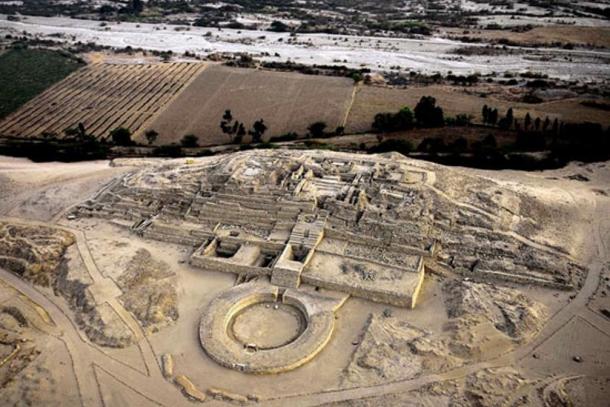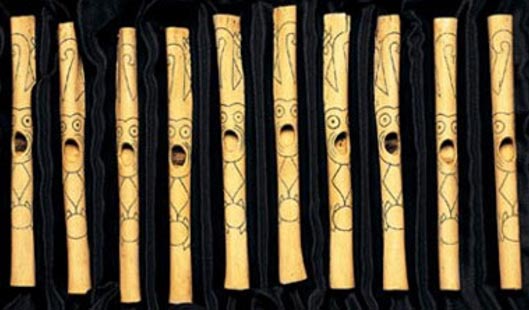
What Peruvian city-dwellers of 5,000 years ago can teach people of today
In a study in contrasts, architects who use sophisticated technology to design state-of-the-art buildings are looking to the oldest center of civilization in the Americas for inspiration—Caral-Supe in Peru. The UNESCO World Heritage Site features advanced engineering and design that, if replicated, could help modern people live in harmony with nature and each other.
“The International Union of Architects met at the UNESCO World Heritage Site [November 6-8, 2015] and signed a document called the Caral Letter, which hails the ancient city as an example of sustainable urban planning and living in harmony with nature,” says Phys.org in an article about the conference.
The 626-hectare (1,550-acre) city of Caral-Supe was founded around 3000 BC on a dry terrace overlooking the Supe River Valley in the Andes Mountains near the western coast of Peru. No signs of war or violence have been found in the city. In addition, the green valley and its fertile spaces were left uninhabited. Instead the people lived on the less ecologically sensitive desert terrace.
Archaeologists say the city is the probable birthplace of the Quechua language, and thus its influence extended to Macchu Pichu and the Nazca geoglyphs.

Residents of Caral-Supe lived on a desert terrace above the Supe River Valley, which is green for part of the year. Researchers think they did this to preserve as much as possible the green living things in the valley. (Photo by Håkan Svensson/Wikimedia Commons)
While the inhabitants of Caral lacked ceramics and had limited art, they built huge monuments, including pyramids, plazas, amphitheatres, temples, and residential areas, had extensive agriculture, ate a varied diet, developed the use of textiles, used a complex system for calculating and recording, built water supply, and developed an intricate irrigation system. They traded widely with neighboring societies, reaching at least as far as the Amazon jungle, as evidenced by carvings of monkeys.

The remains of the Sacred City of Caral, Peru. Image source.
Interestingly, no evidence of warfare has ever been found in Caral – no defensive structures, no weapons, and no bodies with violent injuries. Archaeologists believe the people of Caral were a peaceful culture who spent considerable time studying the heavens, practicing their religion and playing musical instruments.
“This is the oldest civilization ever discovered in the Americas, and certainly one of the oldest centers of civilization in the world, almost as old as Mesopotamia and Egypt,” archaeologist Ruth Shady told AFP. She initiated research on the site in 1996. The city was inhabited twice between about 3000 and 1800 BC, was abandoned because of drought and later covered and thus preserved by blowing sands.
"This civilization reached splendiferous and prestigious heights,” Dr. Shady told AFP. “This is a message for the world: It was a place of harmony with nature, protecting the planet and intercultural relations.”

A circular plaza in the city (Photo by Håkan Svensson/Wikimedia Commons)
The residents of the city developed a full socio-political state that had an impact on settlements in the Supe Valley and beyond, says UNESCO. Archaeologists found a quipu, or string recording device that they consider evidence of advanced society.
“The design of both the architectural and spatial components of the city is masterful, and the monumental platform mounds and recessed circular courts are powerful and influential expressions of a consolidated state,” UNESCO says.

The people of Caral fashioned flutes from the bones of condors and pelicans. (Image source)
Jose Arispe, a leading Peruvian architect and an adviser to the International Union of Architects, said he marvels at the engineering feats of the ancient Peruvians. They used air ducts to fan fires that burned during religious rites using a system that physicists call the Venturi effect, which takes advantage of a decrease in pressure when a fluid moves through constricted space. The ancients of Caral-Supe achieved this amazing technology and built their architecturally advanced city using simple tools.
Japanese architects intend to incorporate building designs that protected the ancient people from earthquakes. The people of Caral knew they were in a seismic area and suspended their houses in baskets filled with stones that dissipated earth movement and prevented collapse.
The letter from the group of architects representing 124 nations will be read next month at the United Nations climate conference in Paris. There, the countries of the world will seek an accord to reduce carbon emissions that scientists say are causing the world to grow warmer. Perhaps the world leaders who make war, too, could take note of an advanced people living in perfect peace and harmony with their neighbors.
Featured image: The monolith called Huanca with pyramids in the background in Caral-Supe (Photo by Håkan Svensson/Wikimedia Commons)
By: Mark Miller















